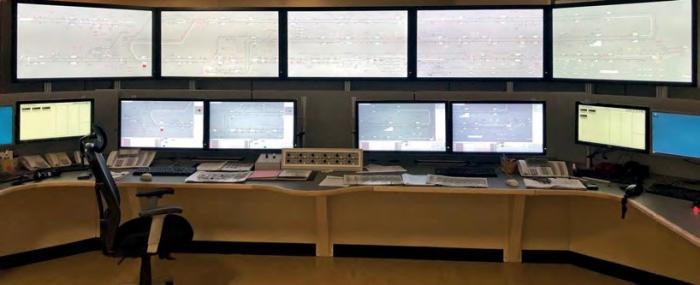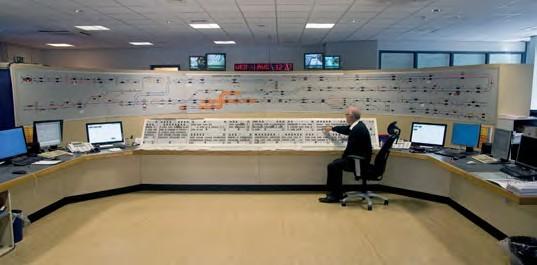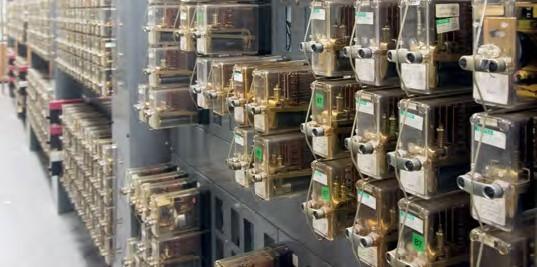NEW CONTROL SYSTEM ON TYNESIDE

A new computerised control system was installed in the Tyne & Wear Metro control room at South Gosforth at the beginning of August. The £12 million upgrade has seen the replacement of the old control desk installed in the early 2000s with a new Scalable system supplied by Derby-based firm Resonate; the old desk in turn replaced the original system commissioned when the Metro opened in 1980.
The previous control systems used the same ‘mimic’ feature to display the network, both system desks having used a single push button to set up a route rather than the entry/ exit process used by many heavy rail installations from the same era. When the control room equipment was first replaced it was decided that a move to a computer-based system would not be right, so TEW was selected to renew the push button system with the equipment that operated through to August 2018. While the old automatic route setting system supplied by French company CSEE worked well, with plenty of flexibility, it was unable to keep pace with technology and there were difficulties obtaining the hardware and dealing with software problems, leading to the decision to replace it with a new system.
BENEFITS
Under the old method of operation trains were allocated a route number for each journey, which the driver selected at the starting station. A transmitter on the train passed this to the control system which set up the route for the train, confirming regularly which train was which via track circuits and radio receivers at every station and other key points around the network. At the end of the journey a new code was entered to set up the train’s next journey.


Intervention by controllers was only required if there was a problem with the infrastructure or a train, making the system easy to operate. However, the transmission of signals between the trains and the signalling control equipment was over public Wi-Fi, which has vulnerabilities, and the software was obsolete. The option of designing new software for the old system was discounted once the benefits of an entirely new system were fully evaluated.
With funding tight it was, however, decided to retain the original 12 Westinghouse interlockings that were installed between 1978 and 1982 and the signalling itself, which is mainly two-aspect with a small number of three-aspect signals in high density areas. Whilst this equipment is almost 40 years old it is working reliably and so the rows of beautifully maintained mechanical relays continue to click away in each of the interlocking locations. Links between the interlockings and the main control centre have been upgraded, with new fibre lines based on the Metro’s IP network which have dual routes around most of the Metro network for added redundancy, whilst a copper line has been retained for additional backup support. The links between the interlockings and the main control centre use the Time Division Multiplex (TDM) system to transmit the messages down the lines; these old Westinghouse S1 type units were also renewed with Delphin 1024 type TDM equipment.
CHANGEOVER
The new system has the network layout displaced on five 65-inch LCD screens in place of the mimic. Train location information is displayed to two controllers, both of whom have two additional smaller screens which allow them to look more closely at any part of the network, and can control individual signals or points, if required in an emergency, via a mouse. Once a train has been identified, as it leaves a depot and enters traffic, the control system will run it to the timetable for the rest of the day without the need for any intervention by the driver or controllers.
The change to the new system took place overnight on Saturday 4 August, with a partial closure of the Metro at 20.00 allowing work at the control centre to begin. Once all trains had finished for the night, the cables to the control desk were cut and it was removed via a window! New tops to the desks were fitted and the PCs and screens for the two new control positions were installed. In front of the mimic five temporary LCD screens were put in place and everything was connected to the new control system, which had already been running in shadow mode for over a year ahead of the switchover. Shortly after 01.00 on Sunday 5 August the new system went live, and by 11.00 services had restarted, albeit without the passenger information screens on stations, which took a few weeks longer to become fully operational. At the end of service on 7 August, with the mimic having been removed, the full size 65-inch screens were installed, completing the transformation of the control room itself. Prior to the switch to the new system controllers were able to learn how to operate it via a simulator, set up to replicate the new control room.
The specific requirements of the Metro created additional challenges for Resonate. As well as the existing interlockings, the system also interfaces with help points and customer information systems, such as platform displays and public address announcements, and the operator’s own performance management and reporting systems. A further interface is with Network Rail’s Tyneside Integrated Electronic Control Centre (IECC), which controls trains on the shared heavy rail/light rail route through Sunderland. Tony Miles
